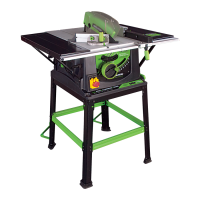(2.6) 5) General Power Tool
Safety Warnings [Service]
a) Have your power tool serviced by a
qualified repair person using only identical
replacement parts. This will ensure that the
safety of the power tool is maintained.
(2.7) HEALTH ADVICE
WARNING: When using this machine,
dust particles may be produced. In some
instances, depending on the materials you
are working with, this dust can be particularly
harmful. If you suspect that paint on the
surface of material you wish to cut contains
lead, seek professional advice. Lead based
paints should only be removed by
a professional and you should not
attempt to remove it yourself.
Once the dust has been deposited on
surfaces, hand to mouth contact can result
in the ingestion of lead. Exposure to even
low levels of lead can cause irreversible brain
and nervous system damage. The young and
unborn children are particularly vulnerable.
You are advised to consider the risks
associated with the materials you are working
with and to reduce the risk of exposure.
As some materials can produce dust that may
be hazardous to your health, we recommend
the use of an approved face mask with
replaceable filters when using this machine.
You should always:
• Work in a well-ventilated area.
• Work with approved safety equipment, such
as dust masks that are specially designed to
filter microscopic particles.
(2.8) WARNING: the operation of any power
tool can result in foreign objects being thrown
towards your eyes, which could result in
severe eye damage. Before beginning power
tool operation, always wear safety goggles
or safety glasses with side shield or a full face
shield where necessary.
ADDITIONAL SPECIFIC SAFETY
RULES FOR TABLE SAWS
a) Do not use saw blades which
are damaged or deformed.
b) Replace the table
insert/access plate if worn.
c) Use only blades as recommended in this
manual, which conform to EN 847-1. When
changing the saw blade beware that the width
of the groove cut of the saw blades shall not
be less than and the thickness of the body
of the saw blade shall not be more than the
thickness of the riving knife.
d) Take care that the selection of the saw
blade is suitable for the material to be cut.
e) Wear suitable personal
protective equipment when necessary.
This could include:
• Hearing protection to reduce the risk of
induced hearing loss.
• Respiratory protection to reduce the risk of
inhalation of harmful dust.
• Wear gloves when handling saw blades and
rough material. Saw blades shall be carried
in a holder whenever practicable.
f) Never perform any operation freehand.
This means using only your hands to support
or guide the workpiece. Always use either the
fence or mitre gauge to position and guide
the work.

